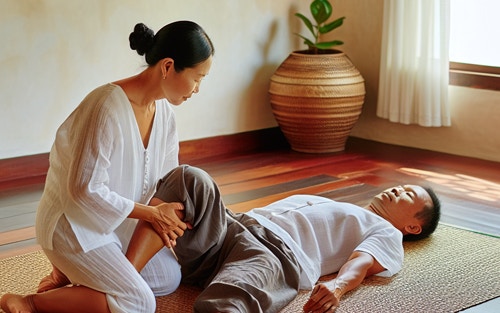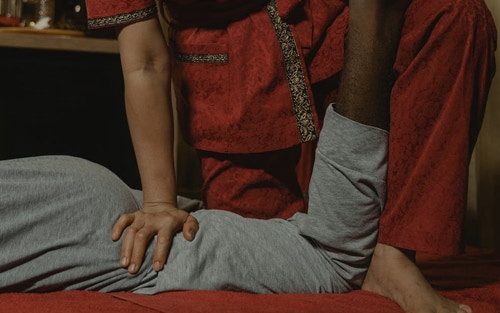Far from the typical kneading and stroking techniques of Western massages, Thai massage weaves together a unique blend of traditional healing practices from Northern India. It’s a dance of gentle pressure, stretching techniques, and yoga-like exercises that bring about a sense of deep relaxation and well-being. Ready to embark on a journey to understand this ancient practice better? Follow along as we explore the roots of Thai Massage, its unique practices, health benefits, and how to integrate it into your wellness routine.

Key Takeaways
- Thai massage is an ancient holistic practice that utilizes assisted yoga, passive stretching, and gentle pressure to balance the body’s energy.
- It provides various benefits, such as improved circulation, pain relief, increased flexibility, and stress reduction.
- Choosing the right licensed practitioner for Thai massage therapy involves verifying and considering qualifications/certification/experience, etc.
Exploring the Roots of Thai Massage
The origins of Traditional Thai massage, known as Nuad bo-rarn, can be traced back more than 2,500 years to Northern India. This practice fuses spiritual and medical traditions. Thai traditional massage, an ancient healing way, involves the use of gentle pressure and stretching techniques to induce relaxation in the entire body. More than just a physical fitness activity or a method of relaxation, traditional Thai massage is designed to facilitate the movement of internal energy throughout the organs and body systems to attain wellness.

The practice works on the body’s energetic pathways, referred to as ‘sen,’ akin to the meridians in traditional Thai medicine and Chinese medicine. The objective is to balance the body’s life energy, enhancing overall health and wellness. While fully clothed and lying on a mat or massage mattress, the therapist guides you through a series of poses and applies pressure to specific energy lines and points on your body. This blend of assisted yoga, passive stretching, and gentle pressure sets Thai massage apart as a unique healing practice.
The Unique Thai Yoga Massage
Thai Yoga Massage transcends the typical confines of massage therapy, offering an immersive experience. It’s a therapeutic practice where the therapist employs their hands and fingers, without the use of oils, to facilitate assisted stretches and exercises.
This practice is quite unique, differing from the Swedish massage, which typically involve the use of oils and focus on muscle kneading and pressure point manipulation.
The Role of the Massage Therapist
In traditional Thai massage, your therapist serves as a guide. They use a blend of pressing and stretching techniques, employing their hands, elbows, knees, and feet to aid you in executing the stretches and movements. The therapist adapts the position and intensity of pressure based on your requirements and comfort. They ensure proper alignment by:
- maintaining body posture
- utilizing meridian line compressing
- stretching
- rocking
- applying static pressure

Leveraging their profound knowledge of anatomy and physiology, Thai massage practitioners stimulate blood circulation using gentle stretches and focused pressure. This technique, known as circulation Thai massage, augments blood flow and oxygen delivery to your muscles and organs, fostering holistic well-being. It’s this focus on circulation and energy flow that sets Thai massage apart from other Western massage techniques.
The Experience on the Mat
Thai massage is distinctive in its setup, with the session taking place on a padded mat or thin mattress on the floor, as opposed to a massage table used in many other forms of massage. This setup offers a more interactive and dynamic session, allowing ample space for the practitioner to maneuver and for you to receive the stretches and movements involved in the session.
The mat contributes to creating a more interactive experience by providing support for various stretches and yoga poses performed by the practitioner. You lie fully clothed on the mat while the practitioner utilizes their own body movements to lead you through stretching and poses, emphasizing a straight back, open shoulders, and a relaxed chest. This setup leads to enhanced flexibility, improved range of motion, and a deeper sense of relaxation.
The Multifaceted Benefits of Thai Massage

Thai massage extends beyond mere relaxation, providing an array of health benefits. Some of the key benefits of Thai massage include:
- Improved blood circulation
- Pain relief
- Increased flexibility
- Stress reduction
- Alleviation of muscle pain and soreness, particularly back pain
Thai massage, performed by skilled massage therapists, encourages holistic well-being and is a great way to take care of your body and mind through Motion Thai Massage.
Both sedentary and active individuals can reap benefits from Thai massage.
Enhancing Circulation and Reducing Pain
Through a combination of gentle stretches and pressure techniques, Thai massage stimulates blood circulation. This technique augments blood flow and oxygen delivery to the muscles and tissues, fostering the natural circulation of blood throughout the body. The result? Decreased pain and a sense of holistic well-being. This is quite distinct from Western massage techniques that often involve using oils and focusing on muscle kneading.
Thai massage also employs a combination of stretching, yoga poses, pulling, and rocking techniques to assist in reducing pain. These techniques contribute significantly to pain relief by relieving tension, easing muscle soreness, and increasing flexibility. The alleviation of pain, coupled with the enhancement of blood circulation, underlines the power of Thai massage as a holistic wellness practice.
Boosting Flexibility and Motion
The inclusion of assisted stretches and exercises in a Thai massage session aids in boosting flexibility and range of motion. This makes it a favorable option for athletes and individuals desiring more profound stretches. Techniques like passive stretching, yoga-like stretches, and joint mobilization are commonly employed in Thai massage. Similar to traditional Chinese medicine, these techniques aim to balance the body’s energy system.

Thai massage has been found to be effective in enhancing flexibility and range of motion by utilizing a combination of compression, acupressure, and passive stretching techniques. This approach increases the range of motion in joints and muscles, making it comparable to the methods used in sports massage and deep tissue massage, which also aim to improve flexibility and mobility.
Psychological Stress Relief
Thai massage extends its benefits beyond the physical realm, providing substantial psychological relief. By alleviating physical tension and fostering a sense of inner peace, Thai massage promotes mental calmness. The incorporation of yoga-like stretches improves circulation and enhances a feeling of calmness, thus reducing anxiety levels.
The power of Thai massage to provide relief from chronic tension-type headaches is also notable. By increasing the pressure pain threshold and reducing the intensity of headaches, Thai massage offers a holistic approach to wellness, integrating both physical and psychological benefits.
When to Avoid Thai Massage
While Thai massage offers many benefits, it isn’t a fit for everyone. Pregnant women, particularly during the initial three months of pregnancy, are advised to avoid Thai massage due to the potential risk of miscarriage. It’s always essential for pregnant women to seek guidance from a certified therapist specializing in prenatal massage before receiving Thai massage or any other treatments.
Similarly, individuals with the following conditions should refrain from Thai massages:
- high blood pressure
- diabetes
- cancer
- recent surgeries
- open wounds
- bleeding disorders
- certain spinal conditions
Furthermore, those who have recently undergone surgery should abstain from Thai massage as it may complicate the healing process or pose additional risks. Always consult your healthcare provider before arranging a Thai massage session to ensure its safety, especially if you have specific medical conditions that may conflict with Thai massages.
Integrating Thai Massage into Your Wellness Routine
The integration of Thai massage into your wellness regimen can foster improvements in physical, mental, and spiritual health. Regular Thai massage sessions, be it weekly or biweekly, can be beneficial for stress management and symptom prevention. Monthly visits could also be effective for general health maintenance.
By reducing stress, increasing energy levels, improving athletic performance and flexibility, and alleviating muscular pains and issues, Thai massage enhances other components of a comprehensive wellness regimen. Engaging in daily maintenance routines that include stretching and relaxation techniques, like Thai massage, can aid in addressing deep muscle tension, improving flexibility, and promoting mental relaxation.
Comparing Thai and Swedish Massages
While both Thai and Swedish massages aim to enhance relaxation and well-being, they offer distinctive experiences and employ different techniques. Thai massage utilizes methods such as deep compressions, passive stretching, and joint mobilization, as opposed to the effleurage, petrissage, tapotement, friction, and vibration typically employed in Swedish massage.
Thai massage and Swedish massage have some key differences:
- Thai massage centers on the balance of the body’s energy system through the manipulation of Sen lines
- Swedish massage primarily aims to alleviate tension in muscles and soft tissues
- Thai massage abstains from using oils, as it emphasizes deep compressions and stretches
- Swedish massage utilizes oils to minimize friction and enhance relaxation
These differences in technique and approach make each type of massage unique.
Choosing the Right Licensed Practitioner
Selecting a licensed practitioner with the proper training and experience is paramount to reaping the full benefits of Thai massage. To become a Thai massage therapist, one must complete a training program approved by the NCBTMB (National Certification Board for Therapeutic Massage and Bodywork) and meet the requisite hours of training to become a licensed massage therapist.
You can verify the licensing of a Thai massage practitioner by confirming their credentials through the appropriate regulatory body in their country or state. When choosing a Thai massage therapist, consider their qualifications, certification, and experience. Reading reviews and seeking recommendations is advisable. Professionalism, effective communication, and maintaining a clean, hygienic environment are essential considerations.
It’s always important to inquire about the following when choosing a Thai massage therapist:
- Their understanding and knowledge of Thai massage therapy
- Their qualifications and experience
- Whether they have insurance coverage
- The types of massages they offer
- The process and benefits of the therapy
Summary
Thai massage offers a unique blend of traditional healing practices, combining gentle pressure, stretching techniques, and yoga-like exercises. Its roots in Northern India and its deep connection with spiritual and medical practices set it apart from other forms of massage. With numerous health benefits, including improved circulation, pain relief, increased flexibility, and stress reduction, Thai massage is a holistic wellness practice worth considering. Whether you’re an athlete looking to enhance your flexibility and range of motion or seeking a deeper sense of relaxation and stress relief, Thai massage could be the missing piece in your wellness routine.
Frequently Asked Questions
What does a Thai massage include?
Thai massage is a traditional technique that combines deep tissue pressure, muscle and joint stretching, gentle manipulations of the body, abdominal work, breath cues, and the application of pressure to specific points on the body. It is performed clothed, on a mat, or on the floor, and can offer relief from pain and symptoms of depression and anxiety.
What do you wear to a Thai massage?
For a Thai massage, wear comfortable clothing that can stretch easily during the session.
What is the significance of the mat in a Thai massage session?
The mat used in a Thai massage session is essential to create a comfortable and supportive surface for the client, thus allowing practitioners to customize techniques based on the client’s needs.
Who should contemplate receiving a Thai massage?
People with an active or passive lifestyle, such as athletes, should consider receiving a Thai massage, as it can improve flexibility and reduce pain.
Is Thai massage considered appropriate for pregnant women?
Generally, it is not recommended for pregnant women to have Thai massage, as it may increase the risk of miscarriage during the initial three months of pregnancy.
(706) 521-5290